I am doing a statistic analysis in a big data frame (more than 48.000.000 rows) in r. Here is an exemple of the data:
structure(list(herd = c(1, 1, 1, 1, 1, 1, 1, 1, 1, 1, 1, 1,
1, 1, 1, 1, 2, 2, 2, 2, 2, 2, 2, 2, 2, 2, 2, 2, 2, 2, 2, 2, 3,
3, 3, 3, 3, 3, 3, 3, 3, 3, 3, 3, 3, 3, 3, 3), cows = c(1, 2,
3, 4, 5, 6, 7, 8, 9, 10, 11, 12, 13, 14, 15, 16, 1, 2, 3, 4,
5, 6, 7, 8, 9, 10, 11, 12, 13, 14, 15, 16, 1, 2, 3, 4, 5, 6,
7, 8, 9, 10, 11, 12, 13, 14, 15, 16), `date` = c("11/03/2013",
"12/03/2013", "13/03/2013", "14/03/2013", "15/03/2013", "16/03/2013",
"13/05/2012", "14/05/2012", "15/05/2012", "16/05/2012", "17/05/2012",
"18/05/2012", "10/07/2016", "11/07/2016", "12/07/2016", "13/07/2016",
"11/03/2013", "12/03/2013", "13/03/2013", "14/03/2013", "15/03/2013",
"16/03/2013", "13/05/2012", "14/05/2012", "15/05/2012", "16/05/2012",
"17/05/2012", "18/05/2012", "10/07/2016", "11/07/2016", "12/07/2016",
"13/07/2016", "11/03/2013", "12/03/2013", "13/03/2013", "14/03/2013",
"15/03/2013", "16/03/2013", "13/05/2012", "14/05/2012", "15/05/2012",
"16/05/2012", "17/05/2012", "18/05/2012", "10/07/2016", "11/07/2016",
"12/07/2016", "13/07/2016"), glicose = c(240666, 23457789, 45688688,
679, 76564, 6574553, 78654, 546432, 76455643, 6876, 7645432,
876875, 98654, 453437, 98676, 9887554, 76543, 9775643, 986545,
240666, 23457789, 45688688, 679, 76564, 6574553, 78654, 546432,
76455643, 6876, 7645432, 876875, 98654, 453437, 98676, 9887554,
76543, 9775643, 986545, 240666, 23457789, 45688688, 679, 76564,
6574553, 78654, 546432, 76455643, 6876)), class = c("tbl_df",
"tbl", "data.frame"), row.names = c(NA, -48L))
I need to identify how many cows are in the following category of glicose by herd and by date:
<=100000
100000 and <=150000
150000 and <=200000
200000 and <=250000
250000 and <=400000
>400000
I tried to use the functions filter() and select() but could not categorize the variable like that.
I tried either to make a vector for each category but it did not work:
ht <- df %>% group_by(herd, date) %>%
filter(glicose < 100000)
Actually I do not have a clue of how I could do this. Please help!
I expect to get the number of cows in each category of each herd based on each date in a table like this:
